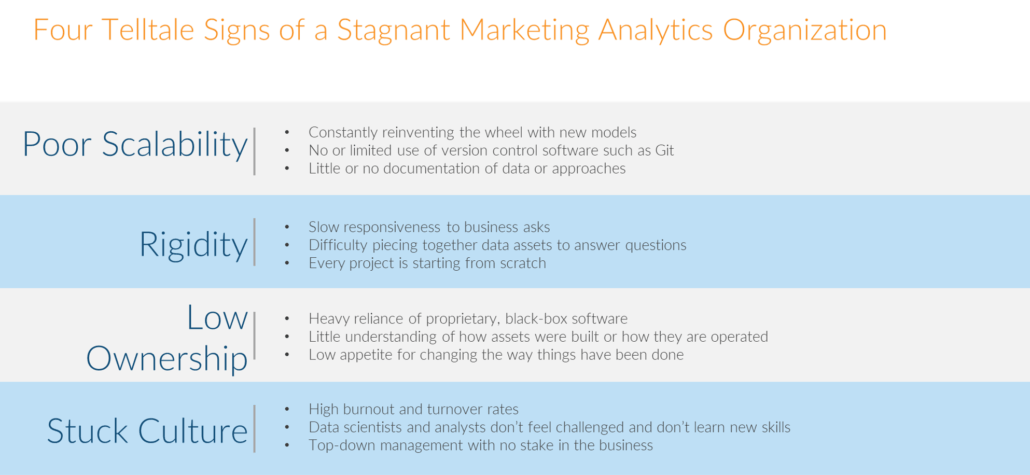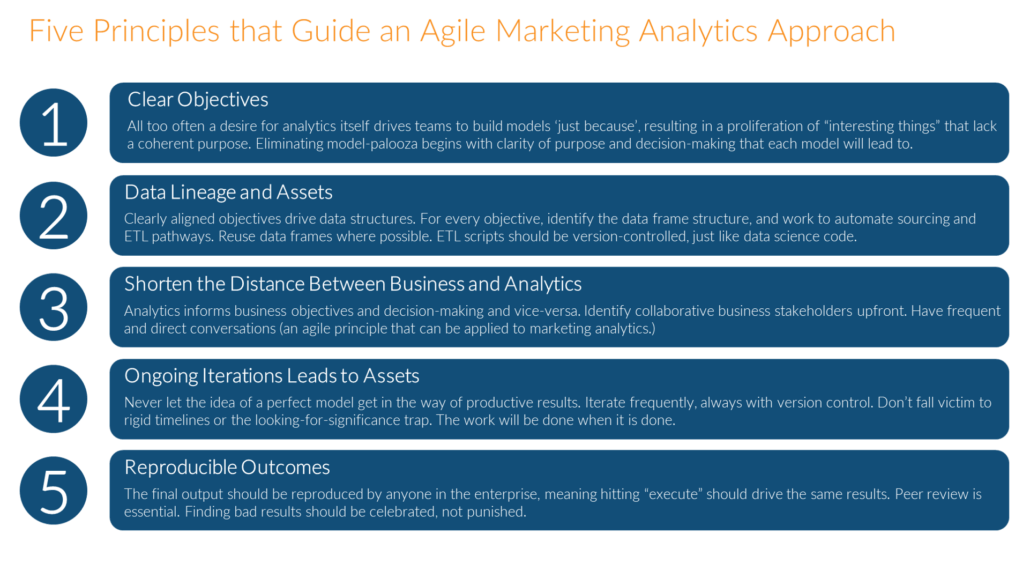4 Signs of Stagnant Marketing Analytics
Marketing analytics organizations are under incredible pressure from business stakeholders. Business owners want everything—and they want it quickly. This insatiable appetite for analytics can lead to demoralized teams who get “C” grades on all their assignments, at best. The result: no one is happy. At MarketBridge, we try to help our clients transform into Agile Marketing Analytics teams. For us, this is more than a catchphrase, it’s the way we do business, and it’s how we help our clients achieve measurably better results on everything from top-of-funnel brand advertising to last-mile lead conversion. Before defining Agile Marketing Analytics, let’s look at the typical baseline state of marketing analytics.
Diagnosing A Stagnant Marketing Analytics Function
When we come in to try to diagnose demoralized, stagnant marketing analytics function, we look for four key, telltale signs of trouble.
- First, we look at how the team works. Is the team using a lot of Excel workbooks to answer questions? Is a version control system like Github being used? Are analysts and data scientists constantly reinventing the work that colleagues did before? Stagnant marketing analytics teams do not deploy scalable methods to solve problems.
- Next, we look at how quickly a team is able to move. If the business asks for an answer, how long does it take to design and field a test—days, weeks, months, or quarters? If a simple descriptive statistic is needed, how long does it take to write the code to get the answer? Minutes, hours, days, or weeks? Teams that take a long time to do simple (or more advanced) tasks are hobbled by seen or unseen snares.
- We then look at assets. Does the team rely heavily on proprietary software to answer questions, or is data and code more open and owned? In other words, how much of the analytics is being done inside black boxes, and how much is actually understood by the team?
- Finally, we examine the culture. Agile marketing analytics organizations are learning organizations. Analysts, data engineers, and data scientists grow quarter over quarter and year over year, tackling new and exciting problems, and adding to their craft. They stay at the organization because they’re happy.
Organizations that struggle in more than one of these areas have room for improvement. Some organizations need more than just improvement—the warning flags are waving across all four, indicating the need for a total overhaul.
How to Improve Analytics Function with 5 Principles
Once an analytics organization has been identified as needing help, there are five principles that can be implemented to improve scalability, flexibility, ownership, and culture.
- All Activity Needs Clear Objectives
All too often, a desire for analytics—any analytics—drives teams to build models “just because,” leading to a proliferation of “interesting things” that lack a coherent purpose. Eliminating model-palooza begins with clarity of purpose. Define the decision-making or actionability that each piece of work or model will enable or lead to. - Relentless Focus on Data Lineage and Asset Creation
Each objective—if defined clearly—implies a data structure or “endpoint” supporting it. The extraction-transformation-loading (ETL, data munging) required to get the data into a tidy shape should be job one, and this process itself should be repeatable and reproducible. By focusing on data endpoints, future agility is baked in. - Shorten the Distance Between Business and Analytics
This comes straight out of the agile manifesto; the closer engineers are to users, the better the product will be. The same goes for marketing analytics. Analytics informs business objectives and decision making, and the business informs analytics. A one-way requirement to analytics path is demoralizing and will lead to stale analyses. Instead, have frequent and direct conversations between business owners and analysts. These aren’t inefficient meetings—they’re critical in generating innovative insights. - Embrace Iteration and Imperfection
As long as you’re keeping track of your changes via version control. Never let the idea of a perfect model get in the way of productive results. Iterate frequently, always using Git. Don’t fall victim to rigid timelines, or the looking-for-significance trap. The work will be done when it is done. - Make Every Deliverable Reproducible
The final output—even if PowerPoint—should be reproducible across the company. Anyone hitting “execute” on the code should get the same results. This isn’t a pipe dream; it’s a scientific principle that ensures that business owners will act only on real results. When reproducibility and quality are glossed over, everything is newsworthy—meaning nothing is. The result is a muddled mess.
This is obviously just the tip of the iceberg when it comes to agile marketing analytics. Transforming your organization fully is a years-long process, but these five principles—applied consistently—will start paying immediate dividends.More on Agile Marketing Analytics
We‘ve been helping consumer and business-to-business brands get to the core of what works and what doesn’t for over 20 years. Learn how we combine discrete (machine learning) and aggregated (econometric) techniques to help you transform with open-source, reproducible data science.
- All Activity Needs Clear Objectives







